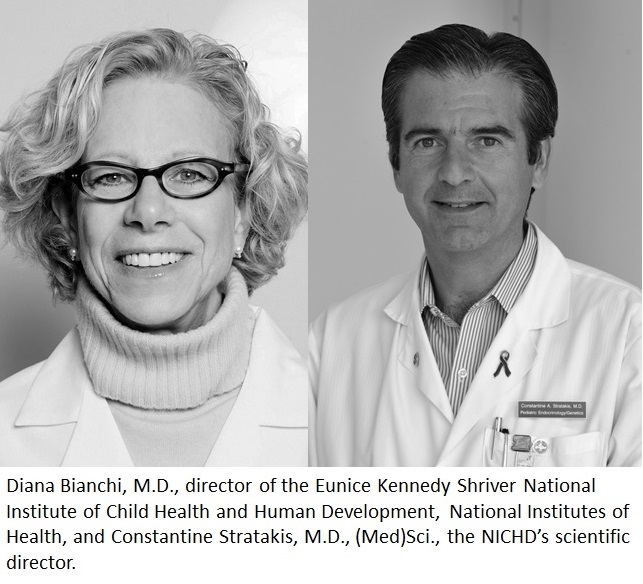
Wayne State University and the Detroit Medical Center will celebrate the 25th anniversary of the Perinatology Research Branch with three days of special on-campus events. Festivities will begin the evening of Aug. 15 with a gathering at the Brush Mall, the outdoor area between Children’s Hospital of Michigan and Harper University Hospital. The reception is open to the full School of Medicine and university communities.
Wayne State University and the Detroit Medical Center will host the celebration, which begins at 7:30 p.m., in Brush Mall. The event will feature music and desserts.
“Wayne State University is proud to host the Perinatology Research Branch of the Eunice Kennedy Shriver National Institute of Child Health and Human Development,” said Jack D. Sobel, M.D., dean of the WSU School of Medicine. “The PRB was established by an act of Congress to address complications of pregnancy that are the leading cause of infant mortality in the United States and worldwide. Congress was cognizant that minorities are disproportionately affected by such complications, which include preeclampsia, preterm birth, fetal and neonatal death, and intrauterine growth restriction. This disparity also extends to maternal morbidity and mortality, as demonstrated by a recent report of the U.S. Centers for Disease Control and Prevention.”
The mission of the PRB, which is part of the Division of Intramural Research, is to conduct research to understand the mechanisms of disease for obstetrical complications and develop diagnostic, prognostic and therapeutic strategies to reduce infant and maternal death, Dean Sobel added. Seminal contributions of the PRB in recent years include:
• The use of progesterone for the prevention of preterm birth in women with a short cervix, which can reduce the rate of preterm birth by 40 percent and save the U.S. health care system $500 million to $750 million annually.
• Discovered the first biomarker of maternal vascular lesions of underperfusion in the placenta – these lesions underlie unexplained fetal death, intrauterine growth restriction and preeclampsia, as well as preterm labor in a subset of patients.
• Identified the first biomarker for unexplained fetal death – a condition for which there was no biomarker or method of prevention in the third trimester. Through the work done in Detroit, a biomarker has been discovered that identifies 80 percent of late fetal deaths with a 10 percent false-positive rate based on a simple blood test. This may lead to better assessment, and a randomized clinical trial to prevent fetal death in patients at risk is being planned.
• Discovered that one of every four preterm births occurs in a mother who has a “silent” infection, and that genital mycoplasmas are the most frequent organisms causing these infections. These infections can be transmitted to the baby, and calls for a re-examination of the standard antibiotic therapy in preterm and term newborns.
• Described the fetal inflammatory response syndrome, a condition that affects unborn babies of mothers with premature labor, and is akin to an adult systemic inflammatory response. This multi-systemic disorder can cause neuroinflammation and fetal cardiac dysfunction, and the finding is a major conceptual breakthrough in the understanding of prematurity, and why premature babies are at risk for cerebral palsy.
• Made pioneering advancements in fetal endoscopic surgery, such as the first case of twin arterial perfusion syndrome (New England Journal of Medicine), the first fetal cystoscopy (Lancet), laser ablation of posterior urethral valves (Lancet) and the development of a patch to treat the rupture of membranes after amniocentesis or surgical procedures (Lancet).
• Invented intelligent navigation sonography, and in particular, fetal intelligent navigation echocardiography, which can be used for the screening of congenital heart disease, the most frequent congenital anomaly by organ system, often undiagnosed before birth.
• Discovered the role of cytokines in the onset of labor.
• Invented an approach for the treatment of cerebral palsy using nanotechnology.
“The success of the PRB has been made possible through the strong partnership with Wayne State University, the Detroit Medical Center and the city of Detroit,” Dean Sobel said. “During the last 25 years, more than 25,000 pregnant women from Detroit have participated in research at the PRB and received care at the DMC by WSU faculty members.”
 Wayne State University will welcome Diana Bianchi, M.D., director of the National Institute of Child Health and Human Development during the celebration. Dr. Bianchi, a pediatrician, neonatologist and medical geneticist of renowned stature, will visit the Wayne State University campus, the Detroit Medical Center and the Perinatology Research Branch.
Wayne State University will welcome Diana Bianchi, M.D., director of the National Institute of Child Health and Human Development during the celebration. Dr. Bianchi, a pediatrician, neonatologist and medical geneticist of renowned stature, will visit the Wayne State University campus, the Detroit Medical Center and the Perinatology Research Branch.
She will deliver a Distinguished Dean’s Lecture titled “From prenatal genomic diagnosis to fetal personalized medicine and beyond” at 11:45 a.m. Aug. 16 in the Green Auditorium in Scott Hall. Her talk will cover the pioneering contributions she has made to noninvasive prenatal diagnosis and the treatment of trisomy 21, also known as Down Syndrome.
Dr. Bianchi will be joined by Constantine Stratakis, M.D., (Med)Sci., scientific director of the NICHD, who is a pediatrician, endocrinologist and medical geneticist of international stature, and who directs the Division of Intramural Research of the NICHD. Dr. Stratakis will present a lecture titled “The genetics of adrenal and pituitary tumor: implications for diagnosis and therapy” Aug. 16 with Dr. Bianchi.
The lectures are open to the School of Medicine community. Due to heightened interest in this special event, it is recommended that attendees arrive early.
Dr. Bianchi and Dr. Stratakis will meet with Roberto Romero, M.D., chief of the PRB, and leadership of WSU, including Dean Sobel and section heads of units of the PRB who are WSU faculty members, on Aug. 16.
“We are delighted to host Dr. Bianchi and Dr. Stratakis, who have been protagonists of the genomic revolution in medicine,” Dr. Romero said.
